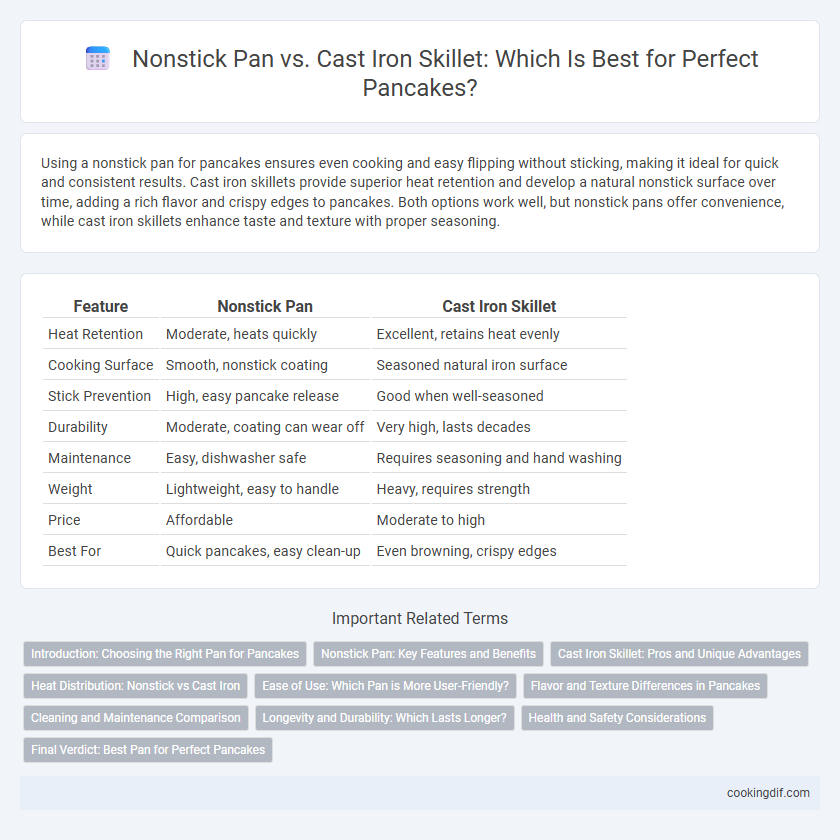Using a nonstick pan for pancakes ensures even cooking and easy flipping without sticking, making it ideal for quick and consistent results. Cast iron skillets provide superior heat retention and develop a natural nonstick surface over time, adding a rich flavor and crispy edges to pancakes. Both options work well, but nonstick pans offer convenience, while cast iron skillets enhance taste and texture with proper seasoning.
Table of Comparison
| Feature | Nonstick Pan | Cast Iron Skillet |
|---|---|---|
| Heat Retention | Moderate, heats quickly | Excellent, retains heat evenly |
| Cooking Surface | Smooth, nonstick coating | Seasoned natural iron surface |
| Stick Prevention | High, easy pancake release | Good when well-seasoned |
| Durability | Moderate, coating can wear off | Very high, lasts decades |
| Maintenance | Easy, dishwasher safe | Requires seasoning and hand washing |
| Weight | Lightweight, easy to handle | Heavy, requires strength |
| Price | Affordable | Moderate to high |
| Best For | Quick pancakes, easy clean-up | Even browning, crispy edges |
Introduction: Choosing the Right Pan for Pancakes
Nonstick pans offer an evenly heated surface that prevents pancakes from sticking and requires less oil, making them ideal for quick, fluffy results. Cast iron skillets provide superior heat retention and develop a natural seasoning over time, enhancing flavor and creating a crispy, golden crust. Selecting between these pans depends on prioritizing ease of use and cleanup versus heat consistency and texture depth.
Nonstick Pan: Key Features and Benefits
Nonstick pans offer a smooth, coated surface that ensures pancakes cook evenly and flip easily without sticking, resulting in perfect texture and shape. They require less oil or butter, promoting healthier cooking and simpler cleanup compared to cast iron skillets. Lightweight and quick to heat, nonstick pans provide efficient temperature control ideal for achieving consistent golden-brown pancakes.
Cast Iron Skillet: Pros and Unique Advantages
Cast iron skillets provide exceptional heat retention and even cooking, ensuring perfectly golden pancakes with a crispy edge and tender center. Their natural nonstick surface improves over time with seasoning, reducing the need for added oils and enhancing pancake flavor. Durable and versatile, cast iron skillets also transition seamlessly from stovetop to oven, allowing for diverse cooking techniques when making pancakes.
Heat Distribution: Nonstick vs Cast Iron
Nonstick pans provide even heat distribution ideal for consistently golden pancakes with minimal hotspots, ensuring uniform cooking without burning. Cast iron skillets, while excellent at retaining heat, can have uneven heating initially but develop a natural nonstick surface over time that enhances pancake flavor and texture. Proper preheating of cast iron is essential for optimal heat distribution, whereas nonstick pans achieve this more quickly due to their thinner construction.
Ease of Use: Which Pan is More User-Friendly?
Nonstick pans excel in ease of use for pancakes due to their lightweight design and effortless release of batter, reducing the risk of sticking and tearing. Cast iron skillets require proper seasoning and preheating, which can be challenging for beginners but provide superior heat retention and even cooking. For those prioritizing convenience and minimal cleanup, nonstick pans offer a more user-friendly experience.
Flavor and Texture Differences in Pancakes
Nonstick pans create pancakes with a uniformly soft texture and a smooth, golden surface due to even heat distribution and easy release, preserving delicate batter consistency. Cast iron skillets enhance flavor by imparting a subtle, smoky aroma and provide a crispier, slightly uneven crust from superior heat retention, resulting in pancakes with a more complex texture contrast. Choosing between the two depends on whether the priority is a tender, flawless finish or rich, robust flavor combined with textural variety.
Cleaning and Maintenance Comparison
Nonstick pans require minimal cleaning effort due to their smooth, coated surfaces that prevent batter from sticking, making them dishwasher safe and less prone to residue buildup. Cast iron skillets demand thorough hand washing without soap, immediate drying, and periodic seasoning with oil to maintain their nonstick properties and prevent rust. Proper maintenance of cast iron ensures durability and enhanced flavor over time, while nonstick pans prioritize convenience and ease of cleaning.
Longevity and Durability: Which Lasts Longer?
Cast iron skillets offer superior longevity and durability due to their heavy-duty construction and ability to withstand high temperatures over time, often lasting decades with proper care. Nonstick pans, while convenient for easy release and cleanup, typically have a shorter lifespan because the nonstick coating can degrade or peel after repeated use and exposure to metal utensils. Investing in a quality cast iron skillet ensures a longer-lasting cooking surface that can improve with seasoning over years, whereas nonstick pans often require replacement every few years to maintain performance.
Health and Safety Considerations
Nonstick pans require careful use to avoid overheating, which can release harmful fumes from synthetic coatings, posing health risks. Cast iron skillets, seasoned naturally, provide a chemical-free cooking surface and can increase iron intake through food. Both options demand proper maintenance; nonstick pans are prone to scratching while cast iron requires regular seasoning to prevent rust and maintain safety.
Final Verdict: Best Pan for Perfect Pancakes
Nonstick pans offer superior ease of use and cleanup, ensuring pancakes release effortlessly with minimal oil, while cast iron skillets provide unmatched heat retention and even browning for a flavorful, crispy crust. For perfectly golden pancakes with minimal fuss, nonstick pans are ideal, especially for beginners. Cast iron is better suited for enthusiasts who prioritize depth of flavor and durability over convenience.
Nonstick pan vs cast iron skillet for pancakes Infographic

 cookingdif.com
cookingdif.com